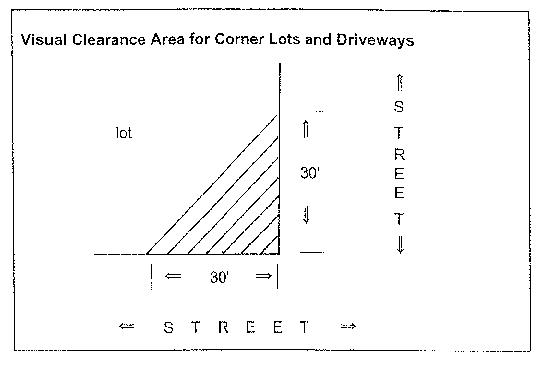Chapter 17.76
VISUAL CLEARANCE AREAS
Sections:
17.76.015 Applicability of provisions.
17.76.020 Visual clearance – Required.
17.76.030 Computation – Nonarterial street and all accessways.
17.76.050 Computation – Arterial.
17.76.010 Purpose.
The purpose of this chapter is to establish standards which will assure proper sight distances at intersections in order to reduce the hazard from vehicular turning movements. (Ord. 2875 § 1.110.010, 2003)
17.76.015 Applicability of provisions.
(1) The provisions of this chapter shall apply to all development including the construction of new structures, the remodeling of existing structures (see SHMC 17.96.020), and to a change of use which increases the on-site parking or loading requirements or which changes the access requirements.
(2) Where the provisions of Chapter 17.96 SHMC, Site Development Review, do not apply, the director shall approve, approve with conditions, or deny a plan submitted under the provisions of this chapter. No notice is required. The decision may be appealed as provided by SHMC 17.24.310(1).
(3) The applicant shall submit a site plan which includes:
(a) The location and height of all hedges, trees, plantings, fences or wall structures within the vision clearance area as computed in SHMC 17.76.030, 17.76.040, and 17.76.050; and
(b) The location of all access points, parking and circulation areas, loading areas and pedestrian walkways within the vision clearance area as computed in SHMC 17.76.030, 17.76.040, and 17.76.050. (Ord. 2875 § 1.110.015, 2003)
17.76.020 Visual clearance – Required.
(1) A visual clearance area shall be maintained on the corners of all property adjacent to the intersection of two streets, a street and a railroad, or a driveway providing access to a public or private street.
(2) A clear vision area shall contain no vehicle, hedge, planting, fence, wall structure, or temporary or permanent obstruction (except for an occasional utility pole or tree), exceeding three feet in height, measured from the top of the curb, or where no curb exists, from the street centerline grade, except that trees exceeding this height may be located in this area, provided all branches below eight feet are removed.
(3) Where the crest of a hill or vertical curve conditions contribute to the obstruction of clear vision areas at a street or driveway intersection, hedges, plantings, fences, walls, wall structures and temporary or permanent obstructions shall be further reduced in height or eliminated to comply with the intent of the required clear vision area.
(Ord. 2875 § 1.110.020, 2003)
17.76.030 Computation – Nonarterial street and all accessways.
A visual clearance area for all street intersections, street and accessway intersections, and street or accessway and railroad track intersections shall be that triangular area formed by the right-of-way or property lines along such lots and a straight line joining the right-of-way or property line at points which are 30 feet distance from the intersection of the right-of-way line and measured along such lines (see figure above). (Ord. 2875 § 1.110.030, 2003)
17.76.040 Exceptions.
Where a right-of-way is greater than what is required, the actual street, railroad, or driveway intersections may be used in lieu of the property lines for computing the visual clearance area. (Ord. 2875 § 1.110.040, 2003)
17.76.050 Computation – Arterial.
On all designated arterial streets the visual clearance area shall not be less than 35 feet on each side of the intersection. (Ord. 2875 § 1.110.050, 2003)


